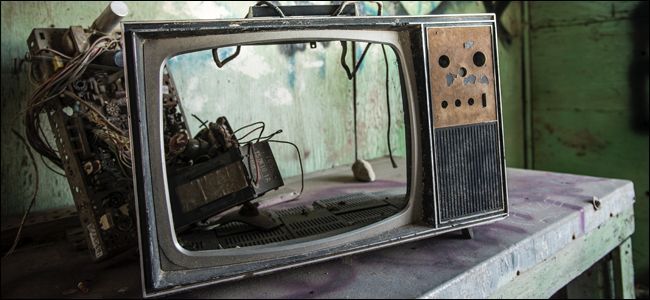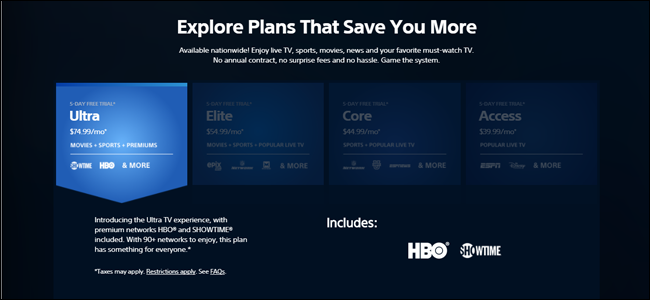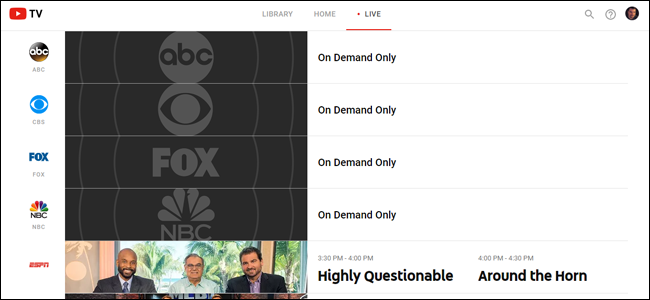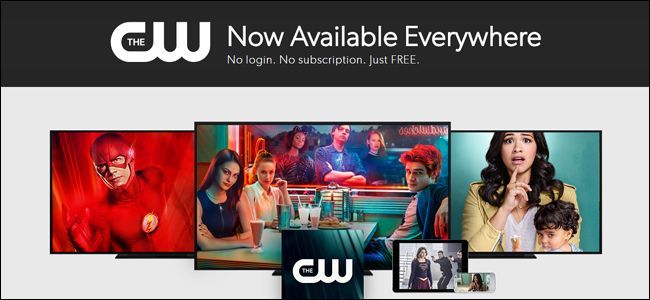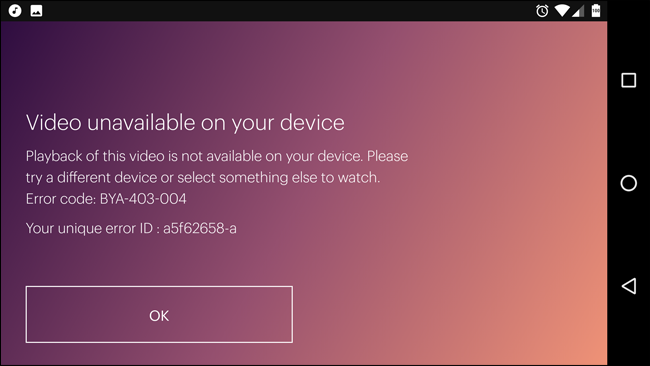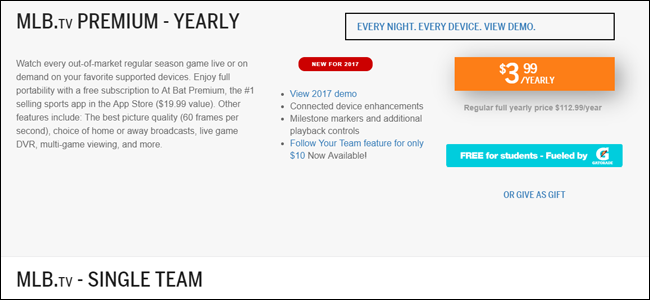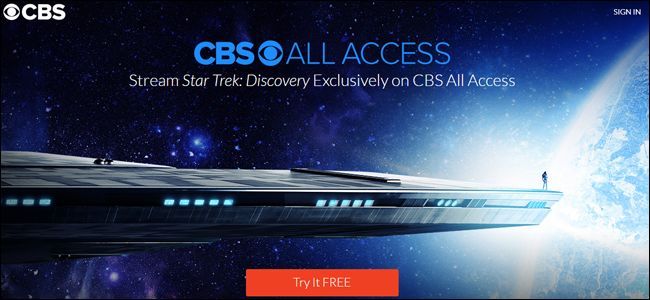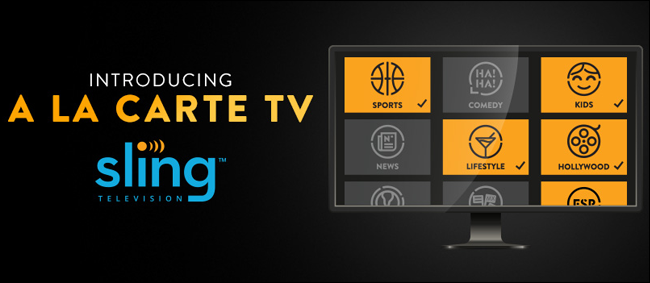Quick Links
Remember a few years ago, when online services were going to slay the anti-consumer demons of DirecTV, Time Warner, and Comcast? Here in 2017, the market for cord-cutting, streaming TV looks a lot more bleak. And thanks to confusing and expensive channel lineups, weird sports restrictions, and more and more exclusive content, the situation isn't going to get better any time soon.
"Packages" Are Alive and Well
The bane of satellite and cable TV is the bundled channel package. If you want any of the more desirable extra channels on cable, you need to subscribe to a bunch of others as well, inevitably including at least some (and sometimes most) channels you don't actually watch. This business model doesn't just let cable companies charge more for what you're not watching, it actually enables those less-watched channels to exist in the first place.
That idea is very much alive for streaming services. PlayStation Vue, Sling TV, DirecTV Now---all of them rely on a bundle system, hiding some of the most watched channels in the country and time-critical premiums like sports channels behind higher tiers. (And why wouldn't they? The latter two are streaming services created by satellite TV providers!)
Thankfully, the lack of hardware, installation, and service charges and extended contracts means that online-only TV is still cheaper and more flexible than cable. But it's more similar than most people were hoping for.
Local Channels Are a Mess...
Just like cable and satellite, your physical location determines which local channels you have access to with streaming services. But it's not as simple as that, because not all local stations are available on all the services. And when those services do have agreements with ABC, CBS, FOX, and NBC at the national level...the independently-owned and franchised local stations that actually deliver over-the-air signals might not be cooperating with the digital streaming system.
Things get even more complicated on the customer side of the equation. When trying out YouTube TV, I was able to access CBS, FOX, and NBC (but not ABC) from the app on my phone, which determined based on my GPS location that the web of licenses and agreements allowed me to watch those networks. But when I logged on to YouTube TV on my home computer, the location determination used my IP address....which shows a location more than a hundred miles away, in another city and market. Suddenly I can't watch any local networks on my larger computer screen.
CBS, while being a big part of the problem in other areas (see the Exclusive Shows section, below), has the right idea here. The CBS All Access service has a centralized system that lets you watch CBS wherever you are...well, sort of. There are still problems with local licensing. When I tried to watch Jeopardy on CBS All Access, like I can over-the-air, my computer's IP address meant that CBS thought I was in another coverage area where the syndicated show is licensed elsewhere. No do doo do theme song for me. All of these channels rely primarily on advertising for income---the more people watch, the more money they make---so why don't they have a unified national stream that you can access? Offering that stream with commercials for free or without commercials for pay would seem to be an obvious solution.
Surprisingly, the best example of a local network getting it right might be The CW. While The CW isn't even offered on most combined streaming systems, and it doesn't offer any decentralized live stream, the company does put every single one of its shows online the following day for free. No week delay, no compulsory cable log-ins, just the shows you want to watch with the commercials that the network needs. CBS and Warner Bros. own the CW, so why can't they learn from its example?
...And So Are Sports
Trying to get all, or even most, of any major American sport on a single cord-cutting plan is an exercise in frustration. Check out our cord-cutting guides for pro football, college football, baseball, and hockey fans---they're Gordian knots of agreements, regional channels, and national services. And of course, if you're trying to watch sports and other scheduled shows, you're only making things harder on yourself. As I said in my college football streaming guide, if you want the best options for live sports, cable or satellite is the only real practical choice.
And even if you do manage to find a service (or multiple services) that covers all the bases (heh) for your sport of choice, you might find that it isn't as simple as that. Local channels and ESPN are offered on every major streaming service, but trying to those apps on your phone or tablet to watch NFL games results in something like this:
That's because in the US, only Verizon is allowed to broadcast live NFL games to mobile devices through its exclusive app. (And funnily enough, that screenshot is from a Verizon phone!) If you access the game from your PC or a set-top streaming box like Roku, or even send the signal you can't see on your phone to your TV via something like Chromecast, it magically becomes accessible again.
We've got an example of good behavior here as well: Major League Baseball. The MLB.tv service allows both an all-you-can-eat plan (around $110 a year) and a single team option ($88 a year) that lets baseball fans watch games on all devices, including the web, smartphones, tablets, set-top boxes, smart TVs, and game consoles. They'd probably make an MLB.tv app for smart fridges if anyone asked. But even in this shining example of connected premium sports, there's a dark spot: local games broadcast on local channels aren't included due to blackout restrictions, and require resorting to an over-the-air antenna.
Sports generate hundreds of billions of dollars in revenue for US broadcasters, and they're not going to stop jealously guarding their various pieces of that pie any time soon.
Exclusive Shows Are Forcing Multiple Purchases
Netflix got an early start on the online streaming boom, and quickly used its revenue to develop exclusive, premium shows like House of Cards and Daredevil. Most of the services that started online are now following in their footsteps: Hulu (The Handmaid's Tale, The Path), and Amazon Prime (Transparent, The Man in the High Castle).
That's all to be expected...Netflix and Amazon need original content to compete with live cable TV. But now conventional broadcast networks are starting to siphon off their content from both streaming services and broadcast or cable customers, by making their own walled gardens. CBS is dropping the first volley by making its new Star Trek: Discovery series exclusive to CBS All Access streaming (at least in the United States). Warner Bros. is working on a superhero-focused streaming service of its own, which will have exclusive rights to a new Teen Titans live action series, among others. And Disney is ramping up its production muscles for a service that will launch sometime in 2019, presumably including new original content, but which will also gradually move all Disney/Marvel/Star Wars properties to its in-house service.
In short, the competition for both new, original productions and the rights to older TV and movie content is getting vicious. The streaming libraries of services like Amazon, Netflix, and Hulu are in constant flux, generally shrinking as rights-holders gather as much content as they can into their own collections. Getting a wider selection of content now required multiple subscriptions...further eroding the economic advantages of streaming services versus cable (unless you rotate your subscriptions, which is a decent-if-annoying workaround).
The crazy thing is, cable customers aren't getting any benefit from this battle: they're just paying companies more to not broadcast new shows on their expensive contract plans.
There's Still No À La Carte Option, and There Probably Won't Be
And here's the biggest insult from streaming TV services: after decades of customers begging for a channel-by-channel subscription option, and even after falsely presenting themselves as à la carte (looking at you, Sling TV), streaming services are still not à la carte.
For clarity's sake, à la carte means paying only for the channels you want to, no more, no less. None of the current streaming options offer this: not PlayStation Vue, not DirecTV NOW, not Hulu or YouTube's live TV options, and absolutely not Sling TV. The biggest anti-consumer sin in cable's long, long naughty list is not being addressed by streaming TV services, and it's unlikely to change, since most of them are still operated by some of the same interests.
There are exceptions, of course. HBO and Showtime both offer a cable-free payment option for their content, and the nature of their broadcasts mean that they don't need a live stream option. Amazon, Hulu, and Netflix offer relatively cheap access to their core libraries, which don't operate as conventional channels anyway.
But the sad state of things is that pay TV customers now have the choice between one big, expensive, limiting option in cable or satellite, and many small, inexpensive, limiting options in streaming TV. And thanks to a fundamental failing of the structure of premium streaming services, those choices aren't going to improve anytime soon. And unlike the shift from cable to streaming, there's no fundamental change in the way we consume entertainment to help kickstart a meaningful change this time around.
Image credit: Tina Rataj-Berard

